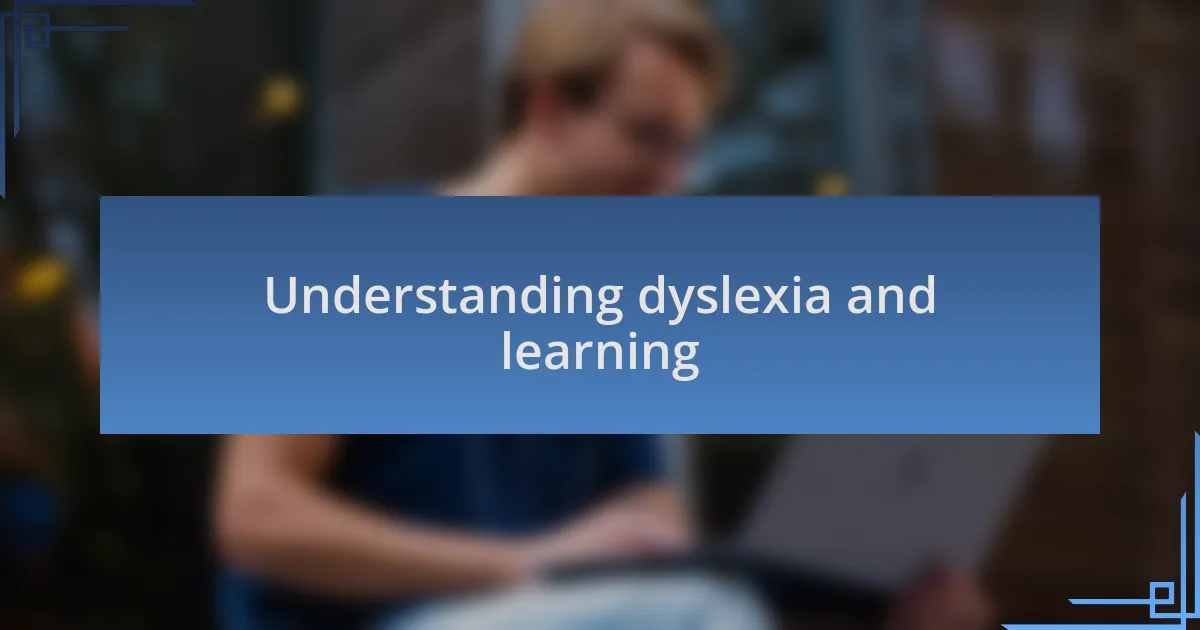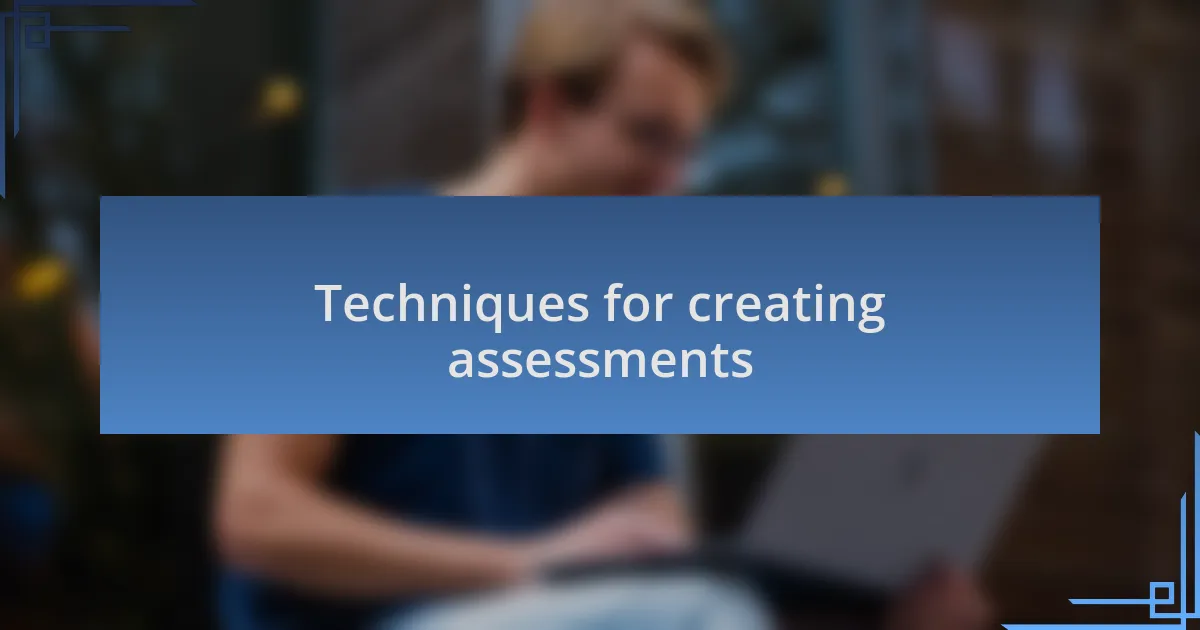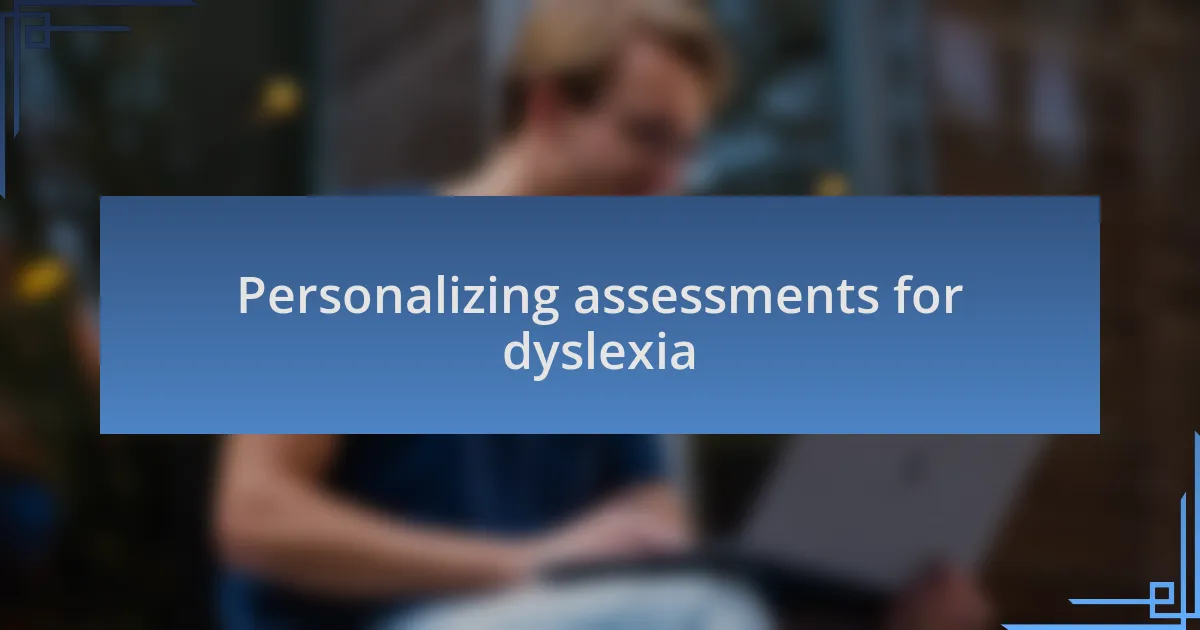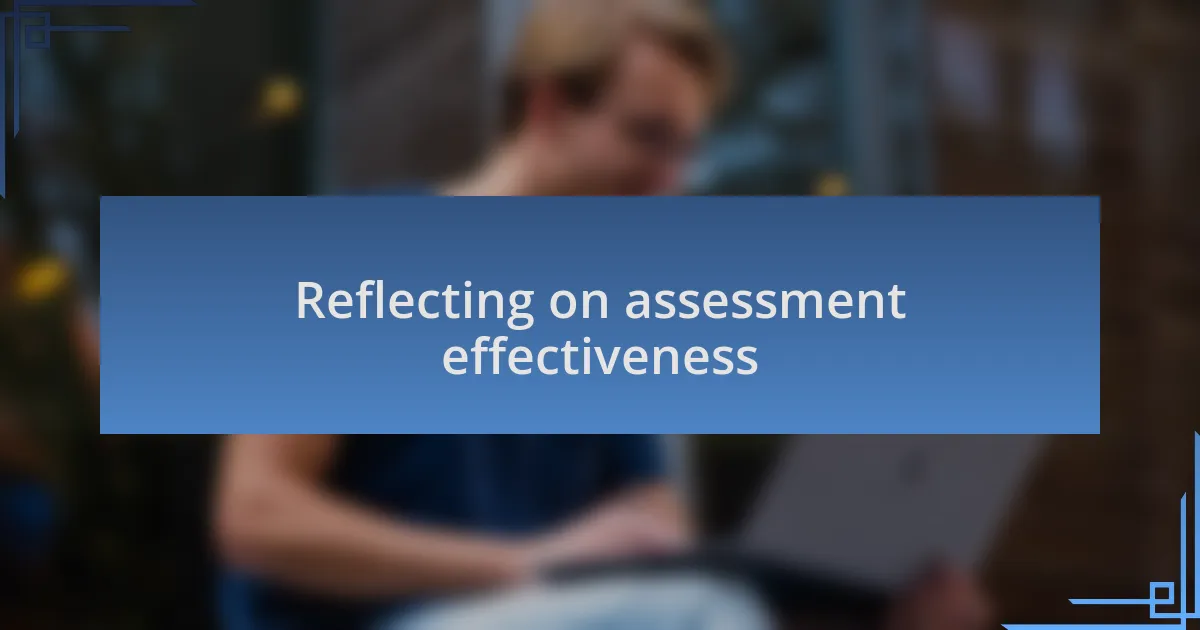Key takeaways:
- Dyslexia is a multifaceted learning difference that can be overcome by utilizing diverse teaching methods and personalized assessments.
- Engaging assessments, which incorporate varied formats and real-world applications, enhance motivation and understanding for students with dyslexia.
- Effective feedback and clarity in instructions are vital in reducing anxiety and improving students’ confidence and performance.
- Personalizing assessments to align with students’ strengths and interests can significantly enhance their learning experience and outcomes.

Understanding dyslexia and learning
Dyslexia is often misunderstood as merely a reading difficulty, but it’s much more complex. I remember when a fellow educator shared how their child, despite having dyslexia, excelled in storytelling when he used visuals. This experience highlighted to me that learning isn’t confined to traditional methods, but rather it thrives in diverse formats.
In my experience working with students who have dyslexia, I’ve witnessed how each individual approaches learning differently. Have you ever seen a child light up when they grasp a concept through hands-on activities rather than words on a page? It’s moments like these that remind me of the power of tailoring education to suit varied learning styles, transforming challenges into newfound strengths.
The emotional journey for learners with dyslexia can be profound, often marked by frustration and self-doubt. I recall a student who, after weeks of struggling with reading, found success when we introduced audiobooks. Watching her confidence bloom was a poignant reminder that understanding dyslexia requires compassion and innovative approaches. How can we harness this insight to create engaging assessments that truly resonate with learners?

Importance of engaging assessments
Engaging assessments are crucial for maintaining student motivation and ensuring understanding, particularly for those with dyslexia. I once facilitated a project where students could choose to create a video presentation instead of a written report. The enthusiasm and creativity that emerged were inspiring; it demonstrated how engagement can lead to deeper learning and a genuine interest in the subject matter.
Additionally, assessments that incorporate various modalities can cater to the unique strengths of learners with dyslexia. I remember implementing a gamified quiz where students competed in teams to answer questions related to their reading material. Not only did they retain information better, but it also fostered a sense of community and support among peers. Isn’t it incredible how a little change in format can empower students to shine?
Ultimately, engaging assessments help to break down the barriers that dyslexia can impose. Reflecting on my own teaching experiences, I’ve seen that when students are actively involved in their assessments, they’re more likely to embrace their learning journey. Isn’t that what we all hope for—students who take ownership of their education and feel confident in their abilities?

Key principles for effective assessments
Effective assessments should be tailored to the diverse learning styles of students. In my experience, creating options allows learners to demonstrate their understanding in ways that resonate with them. For example, during a project on literature, I provided choices between a traditional essay, an artistic representation, or a multimedia presentation. The results were eye-opening; students who often struggled with writing excelled in expressing their thoughts visually.
Another key principle is providing timely feedback. I once had a student who was disheartened after receiving a low score on an initial assessment, but when I sat down with them to discuss their work, we focused on what they did well. The relief and motivation in their eyes were palpable as we identified their strengths and areas for growth. This interaction reinforced my belief that feedback should be a tool for encouragement rather than just a judgement.
Clarity in instructions plays a pivotal role as well. I vividly recall a time when I presented a project with vague guidelines, which left my students confused and anxious. By simplifying the requirements and breaking them down into manageable steps, I witnessed a shift in their confidence. Can you imagine the impact of clear communication in reducing anxiety for students navigating the challenges of dyslexia? I certainly can, and it underlines how crucial this principle is in making assessments accessible and effective.

Techniques for creating assessments
Creating engaging assessments requires more than just a basic understanding of the material. One effective technique I’ve found is incorporating various formats in a single assessment. For instance, during a science unit, I blended multiple-choice questions with hands-on experiments and group discussions. The excitement in the classroom was palpable as students sought to express their knowledge through different avenues, and I could see how their enthusiasm translated into better engagement and understanding.
Another strategy involves using real-world applications to connect learning with students’ lives. I remember designing an assessment where students had to create a business plan for a mock enterprise, incorporating concepts from math and marketing. As they worked, I saw them collaborating, brainstorming, and genuinely caring about the outcome. It’s fascinating how utilizing relatable scenarios can not only ignite passion but also help students retain information better—have you ever noticed how much easier it is to remember something that feels relevant to you?
Lastly, incorporating self-assessment can be incredibly impactful. I often guide my students to reflect on their own learning through journals where they describe what they struggled with and celebrated. When one student shared their feelings of frustration but then acknowledged their improvement, it was a big moment of growth. Self-assessment not only empowers learners but also fosters a mindset of lifelong learning. How do you think giving students a voice in their assessment process could change their attitude towards learning?

Personalizing assessments for dyslexia
When personalizing assessments for students with dyslexia, I focus on understanding their unique strengths and challenges. For example, I once had a student who struggled with traditional reading tasks but had a remarkable talent for storytelling. By allowing them to express their knowledge through verbal presentations instead of written exams, I saw their confidence soar. This shift not only showcased their understanding but also celebrated their individual learning style.
Creating assessments that align with students’ interests has also been a game changer in my experience. One time, I designed a science project themed around video games, which captivated a student who typically disengaged from standard tasks. By integrating their passion, I was able to draw out not just enthusiasm but also deeper comprehension of the material. How often do we see that when we tap into what genuinely excites our students?
Additionally, I find it essential to offer flexible response options. In my classes, I’ve implemented a choice board that allows students to select how they want to demonstrate their understanding—be it through writing, art, or even technology. One student, who often felt overwhelmed, chose to create a digital infographic. Watching them thrive as they engaged with the content in a format that suited them was incredibly rewarding. Isn’t it amazing how a little flexibility can help unlock a world of potential?

Reflecting on assessment effectiveness
Reflecting on assessment effectiveness is a crucial step in my teaching practice. I remember a particular instance when I used a reading fluency assessment that showed little improvement in a student who had previously been struggling. After some reflection, I realized that the assessment didn’t resonate with their interests or learning style. This prompted me to modify my approach, and it was fascinating to see the transformation when I tailored the assessment to better fit their unique needs.
As I reviewed students’ performances on various assessments, I noticed that engagement levels correlated directly with their success. For example, after shifting to more interactive assessments, such as collaborative group presentations, I found that not only did their comprehension improve, but their enthusiasm for learning soared. Have you ever observed how a slight change in the assessment format can completely alter a student’s attitude towards the subject? This reinforces the need to constantly evaluate and refine our assessment strategies.
In my experience, feedback loops play a pivotal role in assessing effectiveness. I encourage my students to share their thoughts on assessments—what worked, what didn’t, and how they felt during the process. I recall one student who admitted feeling anxious about timed tests, prompting me to reconsider how I could make assessments more accommodating. This kind of dialogue not only empowers students but also provides me with invaluable insights that help in designing future assessments tailored for better outcomes. Isn’t it remarkable how much we can learn from simply asking our students?